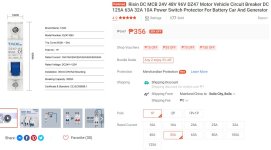If you’ve been using your old breaker as a switch it could be rooted.
The contacts are in all likelihood designed for very intermittent use. Think about their purpose. Data sheet for a regular relay or switch will list the number of rated “switching operations”.
I haven’t looked, but I doubt you’ll find any equivalent rating for an MCB, because they’re unlucky to be flicked twenty times in their lifetime.
There’ll be a thin layer of nickel or other corrosion-resistant material plated on steel. Certainly nothing fancy.
Perhaps expensive high voltage DC rated breakers are more durable, but on regular household types the arcs (audible pops) I’m confident will the plating will disintegrate in short order, after which the steel will corrode and you’re left with a high resistance contact.
If the resistance is high enough, I imagine the heat generated could trip the breaker by exceeding the thermal threshold (as opposed to instantaneous current threshold), which could explain the issue you’re experiencing.
I know that’s a lot of speculation, but it’s only wrong by degrees (or orders of magnitude if I’m way off base). It makes a hell of a lot more sense to use smart BMS’ shutdown/sleep functionality than using breakers as switches.
I’m sure I’ve said this more than once in this thread … the breakers should be regarded as resettable fuses. The incorporated switch is a bonus, and very handy if you want to do some downstream wiring alterations.
The reset function might be useful to get you home, or to the electrical department to buy a replacement breaker, but beyond that, it ought to be treated like any other fuse that is discarded once it blows.
I’m happy to be wrong about this and discover that $5 AC rated MCBs are far less destructible than I imagine. Measure the contact resistance on new vs worn contacts. Crack one open to inspect the contacts. Delve into the datasherts. I won’t bother because of how I use them, but I if I intended to switch them semi-often I would, and you should if you do.
Auto shops are guaranteed to stock blade fuses. If I suggested 40A earlier, I shouldn’t have. Again, I haven’t examined data sheets for them, but IME they’re a fast blow, meaning little headroom above their rating for current spikes, and you might as well seek out an 80A fuse if the purpose is defense against clumsy accidents and stupid lapses of reason.
(Edit: electricity is destructive and dangerous etc etc. Manufacturer guidelines should obviously be followed. Cost cutting by using under-rated equipment is inadvisable. But you’re going to do it, because the 100VDC rated gear costs an arm and a leg. At least test it for your application, before you test it in your application.)





